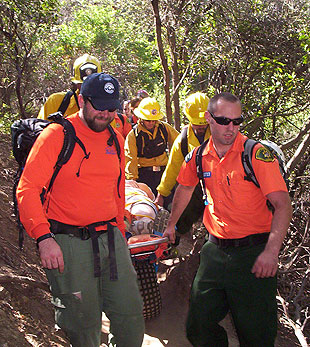TOUCHED BY LYME: Search-and-rescue teams may be at high risk for tick diseases

How to protect yourself in tick territory.
Search-and-rescue teams are highly trained professionals and volunteers who give their time and expertise to help find people who have become lost or injured.
Their work is physically demanding. Depending on location, SAR teams may be required to climb mountains, descend canyons, or hike long miles through rough terrain.
Some work in remote wilderness areas. However, even those based near urban centers spend time in parks, fields, and woods. Which puts them all at risk of exposure to infected ticks.
A young man who is very near and dear to me is currently training to be a SAR volunteer in the San Francisco Bay Area. His south bay county is known to have a lot of disease-carrying ticks, and tick exposure will be a fact of life for him. I want him to do all he can to protect himself.
His training manual has a page on tick protection. It suggests treating clothes with permethrin, frequent tick checks and proper removal techniques. Nothing wrong with that advice, but in my opinion, it’s not detailed enough.
So here, in a nutshell, is what I think SAR teams need to know about ticks:
Ticks can be found in different kinds of terrain, at different times of the year, in different kinds of weather. They come in different sizes. Many are quite small, as easily overlooked as a speck of dirt. They tend to be near the ground—in leaf litter, grasses, bushes, fallen logs and on the lower part of tree trunks. When you brush by them, they may transfer to your shoe, your pant leg or your arm. If your team works with a rescue dog, a tick might hitch a ride on the canine’s fur. And then come on over to you when it gets the chance.
A tick may walk up your clothing until it can access skin. When it strikes, it embeds its mouth parts in you and starts sucking your blood. If left undisturbed, the tick might hang on for several days. During this time, it can transmit diseases. When engorged with your blood, it swells up to the size of a raisin.
Different kinds of ticks can carry different diseases. Your best defense against all tick-borne illness is avoiding being bitten by ticks in the first place. Your second best defense is to quickly find and remove any ticks that latch on to you.
When you’re tromping through scrub brush on a mission to save somebody’s life, you don’t want to worry about bugs. Therefore, my number one piece of advice is to check out Insect Shield clothing. The fabric has been treated with a special process that binds permethrin (an insect repellent) to the fibers. Testing has shown it to be highly effective against ticks, mosquitoes, ants, flies, chiggers, and midges. Protection lasts through at least 70 washings.
At a minimum, I suggest you have Insect Shield pants and shirts. Socks, hats, and other accessories are also available.
(Note: some products are sold through the Insect Shield website.)
Next, I suggest you buy an aerosol can of permethrin to spray your shoes or boots (available at outdoor retailers). Do this outside, in a well-ventilated area, making sure you don’t breathe the vapors.
Ideally, most of your skin will be covered by protective clothing. Apply insect repellent to what is still exposed. DEET, picaridin, and lemon eucalyptus oil are recommended.
While in the field, check yourself periodically for ticks and promptly remove any you find. (Click here for how to remove a tick.)
When you come in for the day, take a shower and thoroughly check your entire body. As you run soapy hands over your skin, feel for unexpected bumps, which may turn out to be embedded ticks.
Pay special attention to hidden spots—behind the ears, hair line, armpits, belly button. And dare I say it—your private parts.
Whether or not you find a tick, stay alert for symptoms that could arise from a tick-borne illness. A bull’s-eye rash indicates Lyme disease, but not everybody with Lyme gets one. You might have a different rash or none at all. You may develop flu-like symptoms—fever, headache, nausea—or joint pain or dizzyness.
Ticks can carry all kinds of nasty stuff—not just Lyme disease. For more information about Lyme and other tick-borne infections, go to www.lymedisease.org.
Search and rescue teams provide a vital service to the community. We thank you for everything you do for us. Now, please protect yourself from ticks and diseases they can transmit. Or you may find yourself unable to carry out the mission you’ve trained so hard far.
Note: The information here is my personal opinion, based on experience, internet research and discussions with a variety of tick prevention experts. I have no affiliation with Insect Shield or any related product.
Click here for more information about Santa Barbara County Search and Rescue (who supplied the accompanying photo).
TOUCHED BY LYME is written by Dorothy Kupcha Leland, LymeDisease.org’s VP for Education and Outreach. Contact her at dleland@lymedisease.org.




















I find it ironic that Santa Barbara shared the rescue photo, as there are no lyme literate doctors in SB.
I had to take my (ILL IN BED FOR FOUR YEARS AND NO SANTA BARBARA PHYSICIAN could figure it out) child to Malibu for diagnosis, and when he tested CDC positive for Lyme, tried to get an infectious disease Doc in SB to treat him. After presenting the positive testing, I was told he didn’t have Lyme Disease, because the doctor disliked the lab!
IDSA is a joke and a laughingstock……..
Santa Barbara needs to wake up and smell the spirochetes.